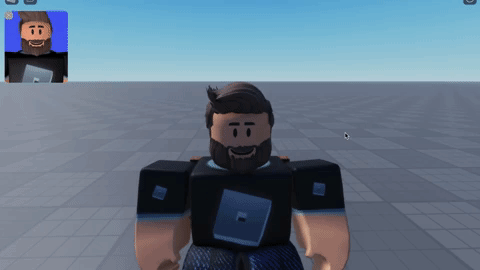Roblox’s avatars are about to get more expressive
Roblox users will soon be able to give their avatars facial expressions that mimic the player's own, the platform announced today.
The update, announced today at the Roblox Developer Conference, will be available only to select creators on the platform for now, but is expected to be widely available to all Roblox users by early 2023.
Roblox, an online game platform on which people can either play games or create them, has 52.2 million users per day. The company's initial demographic was minors, but in recent years it has become a popular destination for teens and young adults, and over half its users are now over 13. The rich, varied virtual worlds created on the site have been considered a precursor to what we might see and experience in the metaverse, with opportunities for connection with other people and personalized avatars that players can use across games.
The update is similar to the Apple iPhone's Bitmoji, which uses depth sensing to measure and track head and facial movements. Previous avatars on Roblox have had expressions, but Bjorn Book-Larsson, vice president of product and avatars at Roblox, described them as two-dimensional."
 ROBLOX
ROBLOXThe Roblox update would mean users could smile, wink, or scrunch their forehead, and their avatar would mimic them in real time. Eyes could scan, heads could shake, and eyebrows and ears could wiggle with the same results. And soon, Roblox says, users will be able to speak directly with other avatars as in other multiplayer video games. In short, the changes might blend our real-world human experience with that of the metaverse and make avatars more like ourselves-for better or worse.
Until early 2023, these updates will be kept within a tight circle of users and creators, which Book-Larsson says is meant to maintain trust and safety." We expect the unexpected," he says. Part of that lag is so that Roblox's safety team can make sure expressions are safely deployed within its huge demographic of minor users. For example, Book-Larsson says, one option for a facial expression-sticking your tongue out-was scrapped because of its possible misuse as a sexual overture.
The slow rollout will also provide a chance to see how older users will take to their avatars' ability to emote emoting. Book-Larsson says that the fastest-growing demographic of users is 17- to 24-year-olds, a cohort that has many social media and gaming platforms to choose from. The hope is that they will be more engaged" with emotional avatars, Book-Larsson says, and in turn, spend more time on the platform.
One expert, however, says Roblox needs to be careful about how expressions are read across cultures. Reading a smile as happy is a very Western stereotype," says Lisa Feldman Barrett, a neuroscientist and the author of How Emotions Are Made. Since 44.7% of Roblox users live in non-Western countries, that's a valid concern.
Book-Larsson says that smiles and other expressions communicating happiness are the most popular ones on Roblox now. But in some cultures, a smile can convey invitation or supplication. Even if two players are Western, they may experience a smile differently: perhaps menacingly, perhaps as sarcasm.
Book-Larsson says he recognizes these possible consequences of making avatars more expressive and emphasizes that it's part of the reason why the rollout is so slow. And as Feldman Barrett points out, verbal communication is key to accurate emotional understanding. Book-Larsson says avatars will be able to do that via voice chat soon. We want to make sure it's safe," he says. We're about to find out."